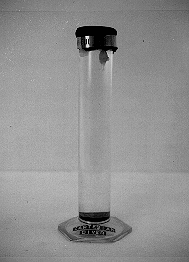Cartesian Diver
Purpose
To demonstrate a variety of fluid mechanics phenomena, including the compressibility of a gas, the incompressibility of water, Boyle's law, Pascal's law, and Archimedes' law.
Equipment
Tube with diver and sealed membrane, as photographed.
Suggestions
This is a small version. For larger version see F2-03: CARTESIAN DIVER - EXPLICIT VERSION.
Images

Description
The diver is carefully weighted with water. When the rubber membrane on the top of the tube is pressed, the air in the diver is compressed, allowing enough water to enter the tube that its average density becomes greater than that of water, and the diver sinks. When the membrane is released the diver again rises to the top of the tube. ◙
References
Julius Sumner Miller, Extensions of the Cartesian Diver Experiment, AJP 22, 235-236, (1954). ◙John Satterly, Rate of Rise of Small Air Bubbles in Water, AJP 23, 387 (1955). ◙R. Stuart Mackay, Automatic Cartesian Diver, AJP 26, 403-404 (1958). ◙Robert N. Jones, The Cartesian Diver, TPT 11, 345, (1973). ◙Jack Willis and Donald F. Kirwan, Easily-Performed Experiment Illustrating the Effect of Buoyant Force of Air on Laboratory◙Weighings, AJP 42, 910-911 (1974). ◙Haym Kruglak, The Rising Cartesian Diver, TPT 13, 68-69, (1975). ◙Martin Gardner, Physics Trick of the Month: The Cartesian Matches, TPT
